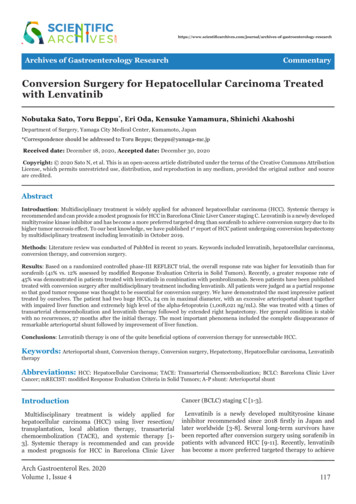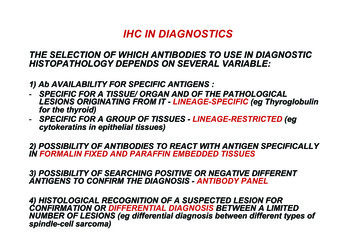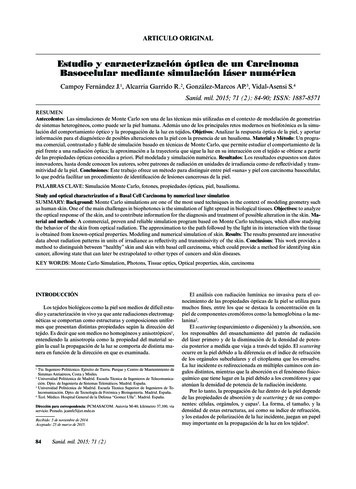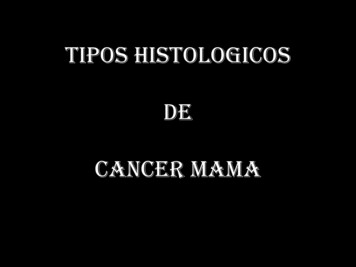
Transcription
s-of-gastroenterology-researchArchives of Gastroenterology ResearchCommentaryConversion Surgery for Hepatocellular Carcinoma Treatedwith LenvatinibNobutaka Sato, Toru Beppu*, Eri Oda, Kensuke Yamamura, Shinichi AkahoshiDepartment of Surgery, Yamaga City Medical Center, Kumamoto, Japan*Correspondence should be addressed to Toru Beppu; tbeppu@yamaga-mc.jpReceived date: December 18, 2020, Accepted date: December 30, 2020Copyright: 2020 Sato N, et al. This is an open-access article distributed under the terms of the Creative Commons AttributionLicense, which permits unrestricted use, distribution, and reproduction in any medium, provided the original author and sourceare credited.AbstractIntroduction: Multidisciplinary treatment is widely applied for advanced hepatocellular carcinoma (HCC). Systemic therapy isrecommended and can provide a modest prognosis for HCC in Barcelona Clinic Liver Cancer staging C. Lenvatinib is a newly developedmultityrosine kinase inhibitor and has become a more preferred targeted drug than sorafenib to achieve conversion surgery due to itshigher tumor necrosis effect. To our best knowledge, we have published 1st report of HCC patient undergoing conversion hepatectomyby multidisciplinary treatment including lenvatinib in October 2019.Methods: Literature review was conducted of PubMed in recent 10 years. Keywords included lenvatinib, hepatocellular carcinoma,conversion therapy, and conversion surgery.Results: Based on a randomized controlled phase-III REFLECT trial, the overall response rate was higher for lenvatinib than forsorafenib (41% vs. 12% assessed by modified Response Evaluation Criteria in Solid Tumors). Recently, a greater response rate of45% was demonstrated in patients treated with lenvatinib in combination with pembrolizumab. Seven patients have been publishedtreated with conversion surgery after multidisciplinary treatment including lenvatinib. All patients were judged as a partial responseso that good tumor response was thought to be essential for conversion surgery. We have demonstrated the most impressive patienttreated by ourselves. The patient had two huge HCCs, 24 cm in maximal diameter, with an excessive arterioportal shunt togetherwith impaired liver function and extremely high level of the alpha-fetoprotein (1,008,021 ng/mL). She was treated with 4 times oftransarterial chemoembolization and lenvatinib therapy followed by extended right hepatectomy. Her general condition is stablewith no recurrences, 27 months after the initial therapy. The most important phenomena included the complete disappearance ofremarkable arterioportal shunt followed by improvement of liver function.Conclusions: Lenvatinib therapy is one of the quite beneficial options of conversion therapy for unresectable HCC.Keywords: Arterioportal shunt, Conversion therapy, Conversion surgery, Hepatectomy, Hepatocellular carcinoma, LenvatinibtherapyAbbreviations: HCC: Hepatocellular Carcinoma; TACE: Transarterial Chemoembolization; BCLC: Barcelona Clinic LiverCancer; mRECIST: modified Response Evaluation Criteria in Solid Tumors; A-P shunt: Arterioportal shuntIntroductionCancer (BCLC) staging C [1-3].Multidisciplinary treatment is widely applied forhepatocellular carcinoma (HCC) using liver resection/transplantation, local ablation therapy, transarterialchemoembolization (TACE), and systemic therapy [13]. Systemic therapy is recommended and can providea modest prognosis for HCC in Barcelona Clinic LiverLenvatinib is a newly developed multityrosine kinaseinhibitor recommended since 2018 firstly in Japan andlater worldwide [3-8]. Several long-term survivors havebeen reported after conversion surgery using sorafenib inpatients with advanced HCC [9-11]. Recently, lenvatinibhas become a more preferred targeted therapy to achieveArch Gastroenterol Res. 2020Volume 1, Issue 4117
Sato N, Beppu T, Oda E, Yamamura K, Akahoshi S. Conversion Surgery for Hepatocellular Carcinoma Treated withLenvatinib. Arch Gastroenterol Res. 2020; 1(4): 117-123.conversion surgery due to its higher tumor necrosis effectevaluated by the modified Response Evaluation Criteria inSolid Tumors (mRECIST) [12-16]. To our best knowledge,we have published 1st report of HCC patient undergoingconversion hepatectomy by multidisciplinary treatment,including lenvatinib, in October 2019 [12].This paper summarized the current status of conversiontherapy for advanced HCC using lenvatinib.Conversion Surgery after MultidisciplinaryTreatment Including LenvatinibThe number of radical conversion surgery has increasedafter lenvatinib therapy in recent years [12-16]. Overall,five papers including seven patients have been published(Table 1). Conversion surgery included liver resectionand thermal ablation with operative microwave andradiofrequency.Impact of Lenvatinib in Conversion The median age of the patients was 70 years (range,66–82 years) and three patients (43%) were male. MedianTherapy for Hepatocellular CarcinomaBecause advanced HCCs frequently show hypervascularnature, the therapeutic effect of systemic therapy isassessed not only by the tumor regression effect usingthe RECIST criteria but also tumor necrosis effect usingthe mRECIST criteria [17]. The higher response ratecan provide a better liver resection rate in patients thatunderwent conversion surgery for initially unresectablecolorectal liver metastases [18]. Consequently, similartendency can be observed for HCC patients treated withliver resection following systemic therapy. Based on arandomized controlled phase-III REFLECT trial, theoverall response rate was higher for lenvatinib than forsorafenib (41% vs. 12% and 19% vs. 7% for mRECIST andRECIST 1.1, respectively) [19].The efficacy and safety of lenvatinib were assessed foradvanced HCC patients beyond the inclusion criteria ofthe REFLECT trial. The patients had a tumor with themain portal vein tumor thrombus (Vp4) or with 50%liver occupation. Response rates were 20.0% and 29.3%in the former and latter groups by mRECIST criteria,respectively [20]. Another study confirmed that theresponse rates according to Child–Pugh classification (A:56.0% vs. B: 45.8%) or liver occupation of HCC ( 50%:56.3% vs. 50%: 33.3%) were not significantly differentby mRECIST criteria [21]. Lenvatinib showed an excellenttumor necrosis effect inside and outside of the REFLECTcriteria.Recently, a greater response rate of 45% by mRECISTcriteria was demonstrated in patients treated withlenvatinib in combination with pembrolizumab [22]. Theirresponse rate is higher than those of patients undergoinghepatic arterial infusion chemotherapy (36%) or anovel standard systemic therapy with atezolizumab andbevacizumab (27%) [23,24]. The half-life of the lenvatinibplasma concentrations is short at approximately 28–35 h[25]. Therefore, 7–10 days is believed to be sufficient asa cessation time before conversion surgery [12]. Takentogether, lenvatinib must be one of the recommendableoptions to be used for conversion therapy.Arch Gastroenterol Res. 2020Volume 1, Issue 4tumor size and number was 10 cm (range: 5.2–24) and3 (range: 1 to many), respectively. Five patients (72%)had non-hepatitis B and C, one (14%) patient had distantmetastasis, three (43%) patients were in BCLC stage C,and all patients except one had previous treatments forHCC and Child–Pugh A immediately before conversionsurgery. All patients and five of seven patients were judgedas a partial response by mRECIST and RECIST criteria,respectively. Good tumor response was thought to beessential for conversion surgery. The median durationof lenvatinib therapy was 10 months (range, 1.2–13). Inaddition, conversion surgery included five hepatectomiesand two microwave ablations. Postoperative therapiesincluded two lenvatinib therapies and one TACE. Onepatient expired of postoperative complications for primarylung cancer without HCC recurrence [13]. The remainingpatients were alive without recurrence for 3–21 months.However, the observational period is not long enoughto assess the true survival benefit of conversion surgery.Considering strict definition of conversion therapy thatmake unresectable HCC to be resectable, case 1, 4, 5, and 6are true conversion cases.Two patients were treated in our institution [12,13] andthe most impressive patient is introduced [12]. The patienthad two huge HCCs, 24 cm in maximal diameter, with anexcessive arterioportal shunt (A-P shunt) (Figure 1A–1Cand Figure 2A). Moreover, the patient had impaired liverfunction consisting of 2.8 g/dL of serum albumin level(normal range, 4.1–5.1), 2.6 mg of total bilirubin (normalrange, 0.4–1.5), and 80.7% of prothrombin activity (normalrange, 70%–140%). Indocyanine green retention rate at15 min (ICG R15) was 24.0% (normal range, 10%), andChild–Pugh score was classified as B (7 points). The levelsof tumor markers on admission were extremely high; thealpha-fetoprotein level was 1,008,021 ( 10 ng/mL) andprotein induced by the absence of vitamin K or antagonistII was 133,298 ( 40 mAU/mL). The patient was judged tobe completely unresectable. Targeted therapy and TACEwith drug-eluting beads was out of indications due toliver dysfunction and A-P shunt, respectively. Therefore,mild conventional TACE using cisplatin lipiodol and118
noneBHCV242noneC(A-P shunt)8B 6A3 2aTACE 44.5PR/PRnoneHepatectomyNo27 AlivenoneEtiologyTumor size (cm)Tumor numberDistant metastasisBCLC stageChild-Pugh gradeArch Gastroenterol Res. 2020Volume 1, Issue 4ALBI gradePrevious Tx and numberDuration of LEN Tx (month)Assessment of LEN therapy(mRECIST / RECIST)Combination drug with LENConversion surgeryPostoperative TxSurvival months after initial TxRecurrencenone11 AliveLENHepatectomyNivolumabNE/SD5TACE 1SorafenibNE8BB/Cnone115HBV69 / M3. Ref. [14]none5 onC82 / F4. Ref. [15]none6 AliveNoHepatectomynonePR/PR6TACE 12a5ABnonemany7.3Alcohol68 / F5. Ref. [16]PR/PRnonePR/PR6TACE 115ABnonemany5.2NASH70 / M7. Ref. [16]none3 AliveNonone6 AliveLENHepatectomy MWAnone6TACE 12a5ABnonemany5.8NASH71 / F6. Ref. [16]Table 1: Surgical intervention after lenvatinib therapy for patients with advanced hepatocellular carcinoma.Evaluation Criteria in Solid Tumour; PR: Partial Response; SD: Stable DiseaseRef.: Reference; HBV: Hepatitis B Virus; HCV: Hepatitis C Virus; NASH: Nonalcoholic Steatohepatitis; Tx.: Treatment; TACE: TransarterialChemoembolization; RFA: Radiofrequency Ablation; LDEV: Laparoscopic Devascularization; MWA: Microwave Ablation; BCLC; Barcelona ClinicLiver Cancer; A-P shunt: Arterioportal shunt; ALBI: Albumin-bilirubin; NE: Not Evaluated; LEN: Lenvatinib; mRECIST: modified Responsenone18 DeadTACEMWAnoneCR/PR1.2RFA, LDEVTACE 515A317NonBNonC75 / M66 / FAge / Sex2. Our caseRef. [13]1. Our caseRef. [12]Case No. / Ref. No.Sato N, Beppu T, Oda E, Yamamura K, Akahoshi S. Conversion Surgery for Hepatocellular Carcinoma Treated withLenvatinib. Arch Gastroenterol Res. 2020; 1(4): 117-123.119
Sato N, Beppu T, Oda E, Yamamura K, Akahoshi S. Conversion Surgery for Hepatocellular Carcinoma Treated withLenvatinib. Arch Gastroenterol Res. 2020; 1(4): 117-123.Figure 1: Contrast-enhanced computed tomography findings. Axial images of the portal phase on admission(A, B). Coronal images of the portal phase on admission (C) and before conversion surgery (D). Main (arrow) andsatellite (arrow head) hepatocellular carcinomas were located in the right liver and in segment 5, respectively. Themain tumor size decreased from 24 cm to 15 cm (37.5% reduction in maximal diameter). Reproduced from Beppu, etal. [12].Figure 2: Digital subtraction angiography. Digital subtraction angiography on the first (A) and the 4th (B)transarterial chemoembolization. A-P shunt (arrows) almost disappeared after lenvatinib administration. Reproducedfrom Beppu, et al. [12].Arch Gastroenterol Res. 2020Volume 1, Issue 4120
Sato N, Beppu T, Oda E, Yamamura K, Akahoshi S. Conversion Surgery for Hepatocellular Carcinoma Treated withLenvatinib. Arch Gastroenterol Res. 2020; 1(4): 117-123.Figure 3: Changes in the levels of tumor markers and treatments. The beginnings to the end of 2019(A) and thereafter until now (B). AFP: Alpha-fetoprotein; PIVKA-II: Protein Induced by the Absence of VitaminK or antagonist-II; TACE: Transarterial Chemoembolization; EVL: Endoscopic Variceal Ligation. Reproduced fromBeppu, et al. [12].Arch Gastroenterol Res. 2020Volume 1, Issue 4121
Sato N, Beppu T, Oda E, Yamamura K, Akahoshi S. Conversion Surgery for Hepatocellular Carcinoma Treated withLenvatinib. Arch Gastroenterol Res. 2020; 1(4): 117-123.gelatin sponge was started [26]. Four times of TACE incombination with lenvatinib therapy was quite effectiveand provided markedly tumor regression and completedisappearance of major A-P shunt (Figure 1D and Figure2B). Thus, the liver function had dramatically improved.Serum albumin, total bilirubin, and prothrombin activitywas 3.52 g/dL, 0.4 mg/dL, and 111.4%, respectively.The Child–Pugh classification improved to A (6 points).ICG R15 and liver resection rate was estimated as 12.8%and 21.4%, respectively. Therefore, extended righthepatectomy was successfully completed without majorpostoperative complications. No postoperative adjuvanttherapy was performed. All tumor markers normalizedwithin 5 months. MAVIRET (glecaprevir hydrate andpibrentasvir), an antiviral therapy for hepatitis C, wasadministered for 12 weeks, after which hepatitis C virusRNA immediately turned negative. Changes in the levelsof tumor markers and treatments are summarized inFigure 3A and 3B. Recent enhanced CT showed good liverregeneration and no tumor recurrence (Figure 3B). Thecondition of the patient was stable with normal levels oftumor markers 27 and 20 months after the initial TACEand hepatectomy, respectively.The most impressive phenomena in this conversionsurgery after lenvatinib therapy included the completedisappearance of remarkable A-P shunt followed byimprovement of liver function. A-P shunt is well known todecrease efficient portal flow. Therefore, the disappearanceof the A-P shunt could provide improved liver functionalreserve. In addition, lenvatinib is a multiple oral tyrosinekinase inhibitor that targets vascular endothelial growthfactor receptors 1–3, fibroblast growth factor receptors1–4, and platelet-derived growth factor receptor β [46]. Therefore, the A-P shunt could be diminished.Consequently, more patients maintained or improvedtheir liver functional reserves when treated with lenvatinibthan those treated with sorafenib (79% vs. 61%) [27].Interestingly, advanced portal hypertension was the onlyindependent predictor of good progression-free survivalafter lenvatinib therapy limited for patients with albuminbilirubin of grades 2 or 3 [28]. Another prospectivecohort study showed that the congestion index (portalvenous area/portal venous flow velocity) significantlyworsened after lenvatinib therapy, which reflects thepathophysiological hemodynamics of the portal venoussystem [29]. The direct effect of lenvatinib therapy onA-P shunt is still unclear. Further studies will be requiredfocusing on the hemodynamics of liver blood flow.In conclusion, lenvatinib therapy is one of the quitebeneficial options of conversion therapy for advancedHCC. In addition, novel combination therapies can providemore opportunities for conversion surgery.Arch Gastroenterol Res. 2020Volume 1, Issue 4Conflict of InterestsAuthors declare no Conflict of Interests for this article.References1. Llovet JM, Brú C, Bruix J. Prognosis of hepatocellularcarcinoma: the BCLC staging classification. InSeminars inliver disease 1999 (Vol. 19, No. 03, pp. 329-338). 1999by Thieme Medical Publishers, Inc.2. Naugler WE, Alsina AE, Frenette CT, Rossaro L, SellersMT. Building the multidisciplinary team for managementof patients with hepatocellular carcinoma. ClinicalGastroenterology and Hepatology. 2015 May 1;13(5):82735.3. Forner A, Reig M, Bruix J. Hepatocellular carcinoma.The Lancet. 2018 Mar 31;391(10127):1301-14.4. Matsuki M, Hoshi T, Yamamoto Y, Ikemori-KawadaM, Minoshima Y, Funahashi Y, et al. Lenvatinib inhibitsangiogenesis and tumor fibroblast growth factor signalingpathways in human hepatocellular carcinoma models.Cancer Medicine. 2018 Jun;7(6):2641-53.5. Ikeda K, Kudo M, Kawazoe S, Osaki Y, Ikeda M,Okusaka T, et al. Phase 2 study of lenvatinib in patientswith advanced hepatocellular carcinoma. Journal ofGastroenterology. 2017 Apr 1;52(4):512-9.6. Kudo M, Finn RS, Qin S, Han KH, Ikeda K, PiscagliaF, et al. Lenvatinib versus sorafenib in first-line treatmentof patients with unresectable hepatocellular carcinoma:a randomised phase 3 non-inferiority trial. The Lancet.2018 Mar 24;391(10126):1163-73.7. Kudo M. Systemic therapy for hepatocellular carcinoma:Latest Advances. Cancers. 2018 Nov;10(11):412.8. Hiraoka A, Kumada T, Atsukawa M, Hirooka M, TsujiK, Ishikawa T, et al. Important clinical factors in sequentialtherapy including lenvatinib against unresectablehepatocellular carcinoma. Oncology. 2019;97(5):277-85.9. Tanaka K, Shimada M, Kudo M. Characteristics of longterm survivors following sorafenib treatment for advancedhepatocellular carcinoma: report of a workshop at the50th Annual Meeting of the Liver Cancer Study Group ofJapan. Oncology. 2014;87(Suppl. 1):104-9.10. Takeyama H, Beppu T, Higashi T, Kaida T, Arima K,Taki K, et al. Impact of surgical treatment after sorafenibtherapy for advanced hepatocellular carcinoma. SurgeryToday. 2018 Apr 1;48(4):431-8.11. Yoshimoto T, Imura S, Morine Y, Ikemoto T, Arakawa122
Sato N, Beppu T, Oda E, Yamamura K, Akahoshi S. Conversion Surgery for Hepatocellular Carcinoma Treated withLenvatinib. Arch Gastroenterol Res. 2020; 1(4): 117-123.Y, Iwahashi S, et al. The outcome of Sorafenib therapyon Unresectable hepatocellular carcinoma: experience ofconversion and salvage hepatectomy. Anticancer Research.2018 Jan 1;38(1):501-7.12. Sato N, Beppu T, Kinoshita K, Yuki H, Suyama K,Chiyonaga S, et al. Conversion hepatectomy for hugehepatocellular carcinoma with arterioportal shunt afterchemoembolization and lenvatinib therapy. AnticancerResearch. 2019 Oct 1;39(10):5695-701.13. Yamamura K, Beppu T, Sato N, Oda E, Kinoshita K, YukiH, et al. Huge hepatocellular carcinoma with extrahepaticcollateral arteries successfully treated by multidisciplinarytreatment including laparoscopic devascularization: a casereport. Clinical Journal of Gastroenterology. 2020 Nov12:1-7.14. Chen X, Zhang Y, Zhang N, Ge Y, Jia W. Lenvatinibcombined nivolumab injection followed by extendedright hepatectomy is a feasible treatment for patientswith massive hepatocellular carcinoma: a case report.OncoTargets and therapy. 2019;12: 7355-9.21. Sho T, Suda G, Ogawa K, Shigesawa T, Suzuki K,Nakamura A, et al. Lenvatinib in patients with unresectablehepatocellular carcinoma who do not meet the REFLECTtrial eligibility criteria. Hepatology Research. 2020Aug;50(8):966-77.22. Finn RS, Ikeda M, Zhu AX, Sung MW, Baron AD, KudoM, et al. Phase Ib Study of Lenvatinib Plus Pembrolizumabin Patients With Unresectable Hepatocellular Carcinoma.Journal of Clinical Oncology. 2020 Jul 27.23. Kudo M, Ueshima K, Yokosuka O, Ogasawara S, ObiS, Izumi N, et al. Sorafenib plus low-dose cisplatin andfluorouracil hepatic arterial infusion chemotherapy versussorafenib alone in patients with advanced hepatocellularcarcinoma (SILIUS): a randomised, open label, phase 3trial. The lancet Gastroenterology & Hepatology. 2018 Jun1;3(6):424-32.24. Finn RS, Qin S, Ikeda M, Galle PR, Ducreux M, KimTY, et al. Atezolizumab plus bevacizumab in unresectablehepatocellular carcinoma. New England Journal ofMedicine. 2020 May 14;382(20):1894-905.15. Matsuki R, Kawai K, Suzuki Y, Kogure M, NakazatoT, Naruge D, et al. Pathological Complete Response inConversion Hepatectomy Induced by Lenvatinib forAdvanced Hepatocellular Carcinoma. Liver Cancer.2020;9(3):358-60.25. Dubbelman AC, Rosing H, Nijenhuis C, Huitema AD,Mergui-Roelvink M, Gupta A, et al. Pharmacokinetics andexcretion of 14 C-lenvatinib in patients with advancedsolid tumors or lymphomas. Investigational New Drugs.2015 Feb 1;33(1):233-40.16. Tomonari T, Sato Y, Tanaka H, Tanaka T, TaniguchiT, Sogabe M, et al. Conversion therapy for unresectablehepatocellular carcinoma after lenvatinib: three casereports. Medicine. 2020 Oct 16;99(42):e22782.26. Beppu T, Ohara C, Yamaguchi Y, Ichihara T,Yamanaka T, Katafuchi S, et al. A new approach tochemoembolization for unresectable hepatocellularcarcinoma using aclarubicin microspheres in combinationwith cisplatin suspended in iodized oil. Cancer. 1991 Dec15;68(12):2555-60.17. Lencioni R, Llovet JM. Modified RECIST (mRECIST)assessment for hepatocellular carcinoma. InSeminars inLiver Disease 2010 Feb (Vol. 30, No. 01, pp. 052-060).18. Folprecht G, Grothey A, Alberts S, Raab HR, KöhneCH. Neoadjuvant treatment of unresectable colorectalliver metastases: correlation between tumour responseand resection rates. Annals of Oncology. 2005 Aug1;16(8):1311-9.19. Kudo M, Finn RS, Qin S, Han KH, Ikeda K, PiscagliaF, et al . Lenvatinib versus sorafenib in first-line treatmentof patients with unresectable hepatocellular carcinoma:a randomised phase 3 non-inferiority trial. The Lancet.2018 Mar 24;391(10126):1163-73.20. Chuma M, Uojima H, Hiraoka A, Kobayashi S, ToyodaH, Tada T, et al. Analysis of efficacy of lenvatinib treatmentin highly advanced hepatocellular carcinoma with tumorthrombus in the main trunk of the portal vein or tumorwith more than 50% liver occupation: a multicenteranalysis. Hepatology Research. 2020 Dec 3.Arch Gastroenterol Res. 2020Volume 1, Issue 427. Terashima T, Yamashita T, Takata N, Toyama T,Shimakami T, Takatori H, et al. Comparative analysis ofliver functional reserve during lenvatinib and sorafenib foradvanced hepatocellular carcinoma. Hepatology Research.2020 Jul 15;50(7):871–84.28. Maesaka K, Sakamori R, Yamada R, Urabe A, TahataY, Oshita M, et al. Therapeutic efficacy of lenvatinibin hepatocellular carcinoma patients with portalhypertension. Hepatology Research. 2020 Sep;50(9):1091100.29. Hidaka H, Uojima H, Nakazawa T, Xue S, Hara Y,Iwasaki S, et al. Portal hemodynamic effects of lenvatinibin patients with advanced hepatocellular carcinoma: aprospective cohort study. Hepatology Research. 2020 Sep27;50(9):1083–90.123
a modest prognosis for HCC in Barcelona Clinic Liver Cancer (BCLC) staging C [1-3]. Lenvatinib is a newly developed multityrosine kinase inhibitor recommended since 2018 firstly in Japan and later worldwide [3-8]. Several long-term survivors have been reported after conversion surgery using sorafenib in patients with advanced HCC [9-11].










